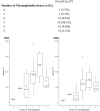Pre-Transplant Immunophenotyping in Pediatric Heart Transplant: A Role for the Immunologist?
- PMID: 39989346
- PMCID: PMC11848703
- DOI: 10.1111/petr.70052
Pre-Transplant Immunophenotyping in Pediatric Heart Transplant: A Role for the Immunologist?
Abstract
Background: Pediatric heart transplant recipients are at risk for complications from prolonged exposure to immunosuppressive drugs, possibly worsened due to over-immune suppression in patients with pre-existing immune abnormalities.
Methods: This was a retrospective, single-center pediatric cohort study and review of baseline immune evaluation in patients referred for heart transplant. Referrals included were from January 1, 2021, to June 31, 2022.
Results: Fifty-one patients were referred during the time period with a median age of 5 years (ranging 1 month-20 years). Twenty-seven total patients were transplanted. Given a lack of standardized immune evaluation, results were focused on lymphocyte quantitation, functional testing when available, and T-cell subsets. Outcome measures focused on the number of infections and episodes of rejection requiring treatment. In total, 44.4% of patients experienced rejection, and the mean number of infections in the first 12 months post-heart transplant was 2.1 (range 0-7 total infections).
Conclusions: Baseline immune evaluation showed general T and B cell lymphopenia, without a clear connection between outcome differences for the number of infections or episodes of rejection requiring treatment. This small study demonstrated some differences in immune function in patients prior to heart transplant but was inadequately powered to draw conclusions about the effects of immunosuppression on post-transplant outcomes.
Keywords: baseline immune phenotype; children; heart transplant; immunosuppression; infections; pediatric heart transplant; rejection; transplant immunology.
© 2025 The Author(s). Pediatric Transplantation published by Wiley Periodicals LLC.
Conflict of interest statement
The authors declare no conflicts of interest.
Figures
Similar articles
-
Safety and early outcomes using a corticosteroid-avoidance immunosuppression protocol in pediatric heart transplant recipients.J Heart Lung Transplant. 2010 May;29(5):517-22. doi: 10.1016/j.healun.2009.11.601. Epub 2010 Jan 12. J Heart Lung Transplant. 2010. PMID: 20061164 Free PMC article.
-
Methotrexate therapy for complex graft rejection in pediatric heart transplant recipients. The Pediatric Heart Transplant Team--Loma Linda.J Heart Lung Transplant. 1995 Jul-Aug;14(4):726-33. J Heart Lung Transplant. 1995. PMID: 7578182
-
The effects of HLA mismatching and immunosuppressive therapy on early rejection outcome in pediatric heart transplant recipients.J Heart Lung Transplant. 1998 Dec;17(12):1195-200. J Heart Lung Transplant. 1998. PMID: 9883760
-
Kidney transplant after hematopoietic cell transplant in pediatrics: Infectious and immunosuppressive considerations.Pediatr Transplant. 2017 Aug;21(5). doi: 10.1111/petr.12929. Epub 2017 Apr 27. Pediatr Transplant. 2017. PMID: 28452096 Review.
-
Prevention and treatment of severe hemodynamic compromise in pediatric heart transplant patients.Paediatr Drugs. 2002;4(11):705-15. doi: 10.2165/00128072-200204110-00002. Paediatr Drugs. 2002. PMID: 12390042 Review.
References
-
- Colvin M. M., Smith J. M., Ahn Y. S., et al., “OPTN/SRTR 2022 Annual Data Report: Heart,” American Journal of Transplantation: Official Journal of the American Society of Transplantation and the American Society of Transplant Surgeons 24, no. 2S1 (2024): S305–S393, 10.1016/j.ajt.2024.01.016. - DOI - PubMed
-
- R Core Team , “R: A Language and Environment for Statistical Computing,” R Foundation for Statistical Computing. Vienna, Austria, https://www.R‐project.org/ (2021).
-
- Human A., Murguia‐Favela L., Benson L., Roifman I., and Grunebaum E., “Cardiovascular Abnormalities in Primary Immunodeficiency Diseases,” LymphoSign Journal 2, no. 3 (2015): 107–134, 10.14785/lpsn-2014-0013. - DOI
MeSH terms
Substances
Grants and funding
LinkOut - more resources
Full Text Sources
Medical




